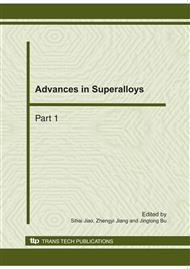p.151
p.156
p.160
p.166
p.170
p.176
p.185
p.189
p.194
Evolution of Recrystallization Microtexture of Cold-Rolling Low Carbon Sheet Steel Based on CSP during Batch Annealing
Abstract:
The mechanism responsible for the formation of recrystallization texture is still disputed although recrystallization texture has long been a subject of research. This is mainly related to the complexity of recrystallization itself .The mechanism of recrystallization microtexture Cold-rolling low carbon sheet steel based on CSP was investigated by the electron back scatter diffraction(EBSD) was investigated. In addition, the origin of nuclei with specific orientations was studied. The results showed that the formation of recrystallization texture is explained by oriented nucleation and the nucleis show around 50% frequency of 15–60°misorientation with their surrounding deformed matrices. Deformed γ-fibre texture components increase more rapidly during the early stage of recrystallization. In contrast, the deformed α-fibre components, such as {001}<110> components disappear rather rapidly early stage of recrystallization and {112}<110> components increases rapidly late stage of recrystallization and grains growth. By microcosmic orientation distribution analyse find that the new {011}<100> grains are nucleated within shear bands in the deformed {111}<112> grains, New {111}<112> grains are nucleated within deformed {111}<110> grains and new {111}<110> grains originated in the deformed {111}<112> grains .
Info:
Periodical:
Pages:
170-175
Citation:
Online since:
October 2010
Authors:
Price:
Сopyright:
© 2011 Trans Tech Publications Ltd. All Rights Reserved
Share:
Citation:


